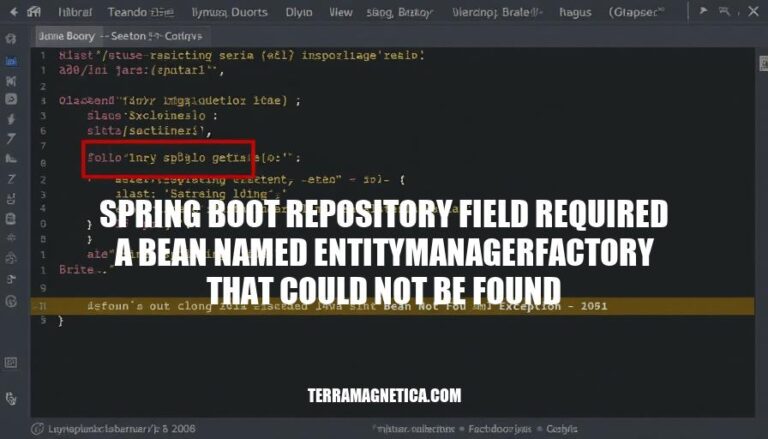


In Spring Boot applications, the error message “repository field required a bean named ‘entityManagerFactory’ that could not be found” typically occurs when the application is unable to locate the EntityManagerFactory bean required for JPA (Java Persistence API) operations. This issue often arises in the context of misconfigured JPA settings, missing dependencies, or incorrect Spring Boot version updates. It is significant because it prevents the application from managing database interactions, which are crucial for data persistence and retrieval in enterprise applications.
Here are the common causes of the ‘spring boot repository field required a bean named entitymanagerfactory that could not be found’ error:
Missing JPA Configuration:
spring-boot-starter-data-jpa.@EnableJpaRepositories.Auto-Configuration Disabled:
Multiple Data Sources:
EntityManagerFactory beans for each data source.Incorrect Entity Scanning:
@EntityScan.Custom Configuration Issues:
EntityManagerFactory configuration, ensure it is correctly defined and the bean name matches what is expected.Persistence Unit Issues:
persistence.xml matches the one used in your configuration.Spring Boot Test Configuration:
EntityManagerFactory.Primary Key Annotation:
@ID annotation with the primary key field in your entity class.Addressing these areas should help resolve the error.
Here’s a step-by-step guide to troubleshoot the ‘spring boot repository field required a bean named entitymanagerfactory that could not be found’ error:
Check Dependencies:
pom.xml or build.gradle file:<dependency>
<groupId>org.springframework.boot</groupId>
<artifactId>spring-boot-starter-data-jpa</artifactId>
</dependency>
<dependency>
<groupId>com.h2database</groupId>
<artifactId>h2</artifactId>
<scope>runtime</scope>
</dependency>
Verify Configuration:
application.properties or application.yml file has the correct JPA and database configurations:spring.datasource.url=jdbc:h2:mem:testdb
spring.datasource.driverClassName=org.h2.Driver
spring.datasource.username=sa
spring.datasource.password=password
spring.jpa.database-platform=org.hibernate.dialect.H2Dialect
Entity Class Annotations:
@Entity and have a primary key annotated with @Id:@Entity
public class User {
@Id
@GeneratedValue(strategy = GenerationType.IDENTITY)
private Long id;
// other fields, getters, and setters
}
Enable JPA Repositories:
@EnableJpaRepositories annotation in your main application class or a configuration class:@SpringBootApplication
@EnableJpaRepositories(basePackages = "com.example.repository")
public class Application {
public static void main(String[] args) {
SpringApplication.run(Application.class, args);
}
}
Check for @SpringBootApplication:
@SpringBootApplication:@SpringBootApplication
public class Application {
public static void main(String[] args) {
SpringApplication.run(Application.class, args);
}
}
Define EntityManagerFactory Bean:
EntityManagerFactory bean in a configuration class:@Configuration
public class JpaConfig {
@Bean
public LocalContainerEntityManagerFactoryBean entityManagerFactory(EntityManagerFactoryBuilder builder, DataSource dataSource) {
return builder
.dataSource(dataSource)
.packages("com.example.entity")
.persistenceUnit("myJpaUnit")
.build();
}
}
Check for Spring Boot Version Compatibility:
Clear Cache and Rebuild:
mvn clean install
Following these steps should help you identify and resolve the root cause of the error.
To prevent the ‘spring boot repository field required a bean named entitymanagerfactory that could not be found’ error, you need to ensure that your Spring Boot application is correctly configured to create the EntityManagerFactory bean. Here are some solutions:
In your application.properties file, make sure you have the following configurations:
spring.datasource.url=jdbc:mysql://localhost:3306/yourdb
spring.datasource.username=root
spring.datasource.password=yourpassword
spring.jpa.hibernate.ddl-auto=update
spring.jpa.show-sql=true
spring.jpa.properties.hibernate.dialect=org.hibernate.dialect.MySQL5Dialect
In your Java configuration class, you can define the EntityManagerFactory bean explicitly:
import org.springframework.context.annotation.Bean;
import org.springframework.context.annotation.Configuration;
import org.springframework.orm.jpa.JpaTransactionManager;
import org.springframework.orm.jpa.LocalContainerEntityManagerFactoryBean;
import org.springframework.orm.jpa.vendor.HibernateJpaVendorAdapter;
import javax.persistence.EntityManagerFactory;
import javax.sql.DataSource;
@Configuration
public class JpaConfig {
@Bean
public LocalContainerEntityManagerFactoryBean entityManagerFactory(DataSource dataSource) {
LocalContainerEntityManagerFactoryBean em = new LocalContainerEntityManagerFactoryBean();
em.setDataSource(dataSource);
em.setPackagesToScan("com.yourpackage.model");
em.setJpaVendorAdapter(new HibernateJpaVendorAdapter());
return em;
}
@Bean
public JpaTransactionManager transactionManager(EntityManagerFactory entityManagerFactory) {
return new JpaTransactionManager(entityManagerFactory);
}
}
If you prefer to rely on Spring Boot’s auto-configuration, ensure your main application class is annotated with @SpringBootApplication and @EnableJpaRepositories:
import org.springframework.boot.SpringApplication;
import org.springframework.boot.autoconfigure.SpringBootApplication;
import org.springframework.data.jpa.repository.config.EnableJpaRepositories;
@SpringBootApplication
@EnableJpaRepositories(basePackages = "com.yourpackage.repository")
public class YourApplication {
public static void main(String[] args) {
SpringApplication.run(YourApplication.class, args);
}
}
Ensure your entity classes are correctly annotated and located in the package specified in entityManagerFactory:
import javax.persistence.Entity;
import javax.persistence.Id;
@Entity
public class YourEntity {
@Id
private Long id;
private String name;
// getters and setters
}
These configurations should help you resolve the EntityManagerFactory bean not found error in your Spring Boot application.
To avoid encountering the ‘spring boot repository field required a bean named entitymanagerfactory that could not be found’ error in future projects, follow these best practices:
Proper Dependency Management:
pom.xml or build.gradle files, especially spring-boot-starter-data-jpa and the appropriate database driver.Configuration:
@Entity and ensure the primary key is marked with @Id.application.properties or application.yml, including spring.datasource.url, spring.datasource.username, spring.datasource.password, and spring.jpa.hibernate.ddl-auto.Bean Definition:
entityManagerFactory bean if auto-configuration does not work. Use @EnableJpaRepositories and @EntityScan annotations to specify the packages for repositories and entities.Debugging:
--debug to get detailed logs and identify configuration issues.By following these practices, you can ensure a smoother development experience and avoid common pitfalls related to dependency management and configuration.
To resolve the ‘spring boot repository field required a bean named entitymanagerfactory that could not be found’ error, ensure your main application class is annotated with @SpringBootApplication and @EnableJpaRepositories.
Check if your entity classes are correctly annotated and located in the package specified in entityManagerFactory.
Proper dependency management is crucial, including spring-boot-starter-data-jpa and the appropriate database driver. Keep dependencies up-to-date to avoid compatibility issues.
Configuration plays a vital role, including defining JPA properties in application.properties or application.yml, such as spring.datasource.url, spring.datasource.username, spring.datasource.password, and spring.jpa.hibernate.ddl-auto.
Explicitly define the entityManagerFactory bean if auto-configuration does not work. Use @EnableJpaRepositories and @EntityScan annotations to specify the packages for repositories and entities.
Debugging with –debug can help identify configuration issues.
By following these practices, you can ensure a smoother development experience and avoid common pitfalls related to dependency management and configuration.